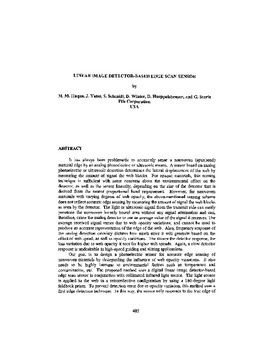| dc.contributor.author | Haque, M. M. | |
| dc.contributor.author | Yates, J. | |
| dc.contributor.author | Schmidt, S. | |
| dc.contributor.author | Winter, D. | |
| dc.contributor.author | Hueppelsheuser, D. | |
| dc.contributor.author | Storie, G. | |
| dc.contributor.other | International Conference on Web Handling (2001) | |
| dc.date.accessioned | 2019-11-08T18:58:48Z | |
| dc.date.available | 2019-11-08T18:58:48Z | |
| dc.date.issued | 2001-06 | |
| dc.identifier | oksd_icwh_2001_haque | |
| dc.identifier.citation | Haque, M. M., Yates, J., Schmidt, S., Winter, D., Hueppelsheuser, D., & Storie, G. (2001, June). Linear image detector-based edge scan sensor. Paper presented at the Sixth International Conference on Web Handling (IWEB), Stillwater, OK. | |
| dc.identifier.uri | https://hdl.handle.net/11244/321810 | |
| dc.description.abstract | It has always been problematic to accurately sense a nonwoven (spunbond) material edge by an analog photoelectric or ultrasonic means. A sensor based on analog photoelectric or ultrasonic detection determines the lateral displacement of the web by measuring the amount of signal the web blocks. For opaque materials, this sensing technique is sufficient with some concerns about the environmental effect on the detector, as well as the sensor linearity, depending on the size of the detector that is derived from the sensor proportional band requirement. However, for nonwoven materials with varying degrees of web opacity, the above-mentioned sensing scheme does not reflect accurate edge sensing by measuring the amount of signal the web blocks as seen by the detector. The light or ultrasonic signal from the transmit side can easily penetrate the nonwoven loosely bound area without any signal attenuation and can, therefore, cause the analog detector to see an average value of the signal it receives. The average received signal varies due to web opacity variations, and cannot be used to produce an accurate representation of the edge of the web. Also, frequency response of the analog detection circuitry dictates how much error it will generate based on the effect of web speed, as well as opacity variations. The slower the detector response, the less variation due to web opacity it sees for higher web speeds. Again, a slow detector response is undesirable in high-speed guiding and slitting applications. | |
| dc.description.abstract | Our goal is to design a photoelectric sensor for accurate edge sensing of nonwoven materials by disregarding the influence of web opacity variations. It also needs to be highly immune to environmental factors such as temperature and contamination, etc. The proposed method uses a digital linear image detector-based edge scan sensor in conjunction with collimated infrared light source. The light source is applied to the web in a retroreflective configuration by using a 180-degree light foldback prism. To prevent detection error due to opacity variation, this method uses a first edge detection technique. In this way, the sensor only responds to the true edge of the web and may avoid problems related to the light source passing through the material. | |
| dc.format | application/pdf | |
| dc.language | en_US | |
| dc.publisher | Oklahoma State University | |
| dc.rights | In the Oklahoma State University Library's institutional repository this paper is made available through the open access principles and the terms of agreement/consent between the author(s) and the publisher. The permission policy on the use, reproduction or distribution of the article falls under fair use for educational, scholarship, and research purposes. Contact Digital Resources and Discovery Services at lib-dls@okstate.edu or 405-744-9161 for further information. | |
| dc.title | Linear image detector-based edge scan sensor | |
| osu.filename | oksd_icwh_2001_haque.pdf | |
| dc.type.genre | Conference proceedings | |
| dc.type.material | Text | |
